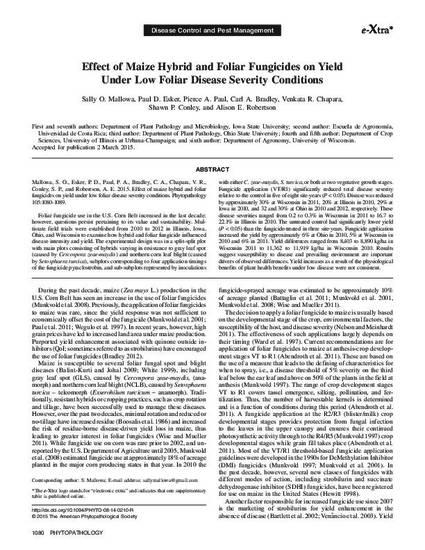
Foliar fungicide use in the U.S. Corn Belt increased in the last decade; however, questions persist pertaining to its value and sustainability. Multistate field trials were established from 2010 to 2012 in Illinois, Iowa, Ohio, and Wisconsin to examine how hybrid and foliar fungicide influenced disease intensity and yield. The experimental design was in a split-split plot with main plots consisting of hybrids varying in resistance to gray leaf spot (caused by Cercospora zeae-maydis) and northern corn leaf blight (caused by Setosphaera turcica), subplots corresponding to four application timings of the fungicide pyraclostrobin, and sub-subplots represented by inoculations with either C. zeae-maydis, S. turcica, or both at two vegetative growth stages. Fungicide application (VT/R1) significantly reduced total disease severity relative to the control in five of eight site-years (P < 0.05). Disease was reduced by approximately 30% at Wisconsin in 2011, 20% at Illinois in 2010, 29% at Iowa in 2010, and 32 and 30% at Ohio in 2010 and 2012, respectively. These disease severities ranged from 0.2 to 0.3% in Wisconsin in 2011 to 16.7 to 22.1% in Illinois in 2010. The untreated control had significantly lower yield (P < 0.05) than the fungicide-treated in three site-years. Fungicide application increased the yield by approximately 6% at Ohio in 2010, 5% at Wisconsin in 2010 and 6% in 2011. Yield differences ranged from 8,403 to 8,890 kg/ha in Wisconsin 2011 to 11,362 to 11,919 kg/ha in Wisconsin 2010. Results suggest susceptibility to disease and prevailing environment are important drivers of observed differences. Yield increases as a result of the physiological benefits of plant health benefits under low disease were not consistent.
Available at: http://works.bepress.com/alison-robertson/241/

This article is published as Mallowa, S. O., Esker, P. D., Paul, P. A., Bradley, C. A., Chapara, V. R., Conley, S. P., and Robertson, A. E. 2015. Effect of maize hybrid and foliar fungicides on yield under low foliar disease severity conditions. Phytopathology 105:1080-1089. doi: 10.1094/PHYTO-08-14-0210-R. Posted with permission.